Agroforestry is intensive land-use management combining trees and/or shrubs with crops and/or livestock. It is an ancient practice; developing counties around the globe have relied on these integrated management strategies for diversifying production and conservation for centuries. In recent decades, researchers have sought to reunite the disciplines of agriculture and forestry to achieve more sustainable production systems and address environmental concerns in the changing nature of traditional farming.
Through careful management, agroforestry practices can:
- diversify products, markets and farm income
- improve soil and water quality
- reduce erosion, nonpoint source pollution and damage due to flooding
- enhance land and aquatic habitats for fish and wildlife
- improve biodiversity while sustaining land resources for generations to come
There are five main practices of agroforestry - alley cropping, forest farming, riparian forest buffers, silvopasture and windbreaks. These practices allow land and forest landowners to realize significant benefits, ranging from value-added income opportunities to long-term land stewardship.
Alley Cropping
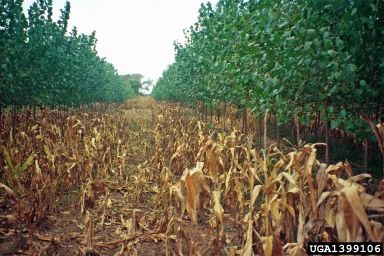 This practice involves the planting of single lines of trees and/or shrubs intercropped in a wide "alley" of either row crops or pasture grasses. Common examples of alley cropping plantings include wheat, corn, soybeans, vegetables or hay planted between rows of black walnut, pecan or other nut and fruit-bearing species. Nontraditional crops include sunflowers or medicinal herbs, Christmas trees, woody florals, etc. Crops in the alleys may change over time as the trees grow and their canopy's cast shade on the alleys.
This practice involves the planting of single lines of trees and/or shrubs intercropped in a wide "alley" of either row crops or pasture grasses. Common examples of alley cropping plantings include wheat, corn, soybeans, vegetables or hay planted between rows of black walnut, pecan or other nut and fruit-bearing species. Nontraditional crops include sunflowers or medicinal herbs, Christmas trees, woody florals, etc. Crops in the alleys may change over time as the trees grow and their canopy's cast shade on the alleys.
Forest Farming
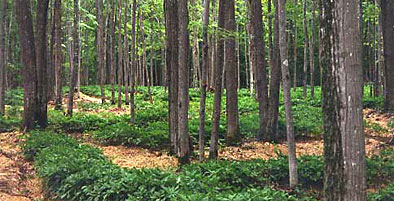 This practice involves the growing of high-value specialty crops under the protection of an existing forest canopy modified to provide the correct shade level. Crops such as bee products (honey, bee pollen, beeswax, royal jelly, etc.), woody florals (grape and bittersweet vines, redosier dogwoods, etc.), fruits and nuts (persimmon, pawpaw, walnuts, pecan, etc.), fenceposts, firewood, maple syrup, medicinal plants (ginseng, goldenseal, cohosh, etc.) and mushrooms can be cultivated using this practice. The forest farming practice emphasizes the fact that both timber and other products can be grown simultaneously.
This practice involves the growing of high-value specialty crops under the protection of an existing forest canopy modified to provide the correct shade level. Crops such as bee products (honey, bee pollen, beeswax, royal jelly, etc.), woody florals (grape and bittersweet vines, redosier dogwoods, etc.), fruits and nuts (persimmon, pawpaw, walnuts, pecan, etc.), fenceposts, firewood, maple syrup, medicinal plants (ginseng, goldenseal, cohosh, etc.) and mushrooms can be cultivated using this practice. The forest farming practice emphasizes the fact that both timber and other products can be grown simultaneously.
Riparian Forest Buffers
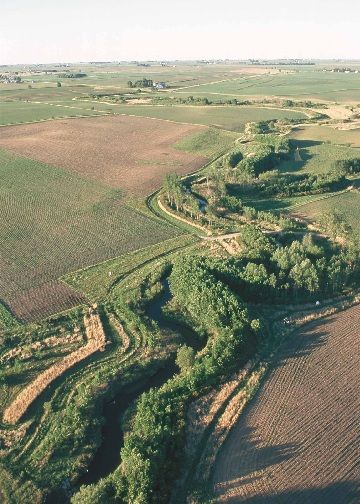 This practice involves establishing living filters comprised of trees, shrubs, forbs and grasses along water systems. These buffers enhance filtration of nutrients from surface run-off and shallow ground water. Riparian forest buffers protect the water quality of streams and lakes and are an effective tool for controlling erosion and providing food and cover for wildlife. Decorative woody florals (redosier dogwood, curly willow, etc.), berries, native grasses and crops can be incorporated into the buffer. This practice requires establishing a series of specific zones - native trees, shrubs and grasses to protect the temperature and clarity of moving water and to keep agricultural chemicals and soil from eroding directly into stream water. As these zones become established, they will begin to take on the appearance of a natural forest.
This practice involves establishing living filters comprised of trees, shrubs, forbs and grasses along water systems. These buffers enhance filtration of nutrients from surface run-off and shallow ground water. Riparian forest buffers protect the water quality of streams and lakes and are an effective tool for controlling erosion and providing food and cover for wildlife. Decorative woody florals (redosier dogwood, curly willow, etc.), berries, native grasses and crops can be incorporated into the buffer. This practice requires establishing a series of specific zones - native trees, shrubs and grasses to protect the temperature and clarity of moving water and to keep agricultural chemicals and soil from eroding directly into stream water. As these zones become established, they will begin to take on the appearance of a natural forest.
Silvopasture
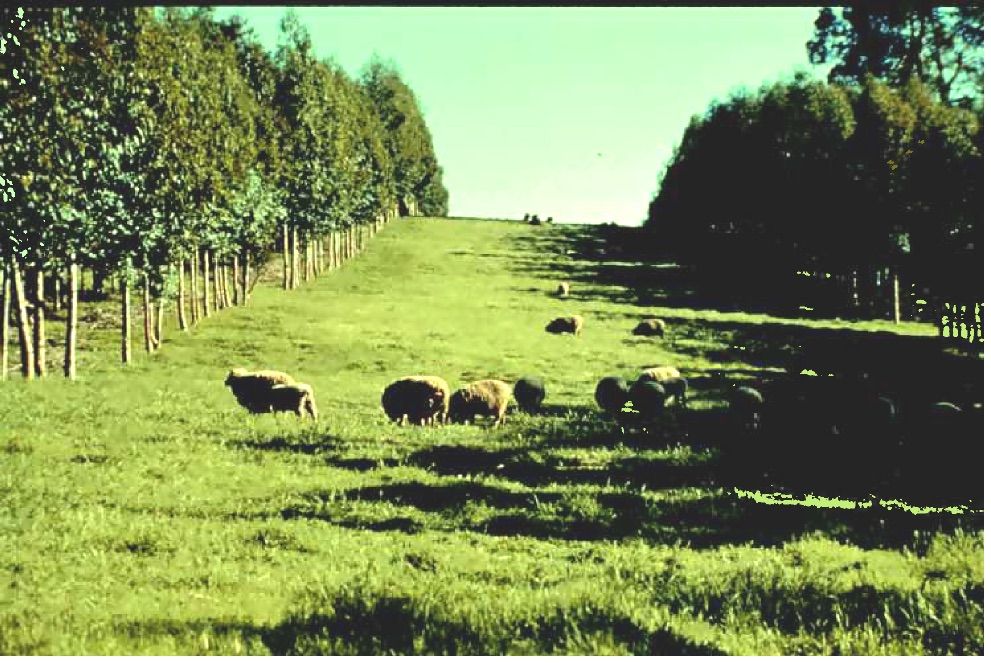 This practice is the intentional combination of trees, forage and livestock managed as a single integrated practice. In a typical silvopasture practice, perennial grasses and/or grass-legume mixes are planted between rows of trees for livestock pasture. The trees not only provide a long-term investment for nut crops or timber, but also provide the animals shade in the summer and shelter in the winter. Cattle and sheep are typically used in silvopastoral practices and rotational grazing practices are utilized. Silvopastoral management creates an environment where trees, forage and livestock can be developed to their full economic potential.
This practice is the intentional combination of trees, forage and livestock managed as a single integrated practice. In a typical silvopasture practice, perennial grasses and/or grass-legume mixes are planted between rows of trees for livestock pasture. The trees not only provide a long-term investment for nut crops or timber, but also provide the animals shade in the summer and shelter in the winter. Cattle and sheep are typically used in silvopastoral practices and rotational grazing practices are utilized. Silvopastoral management creates an environment where trees, forage and livestock can be developed to their full economic potential.
Windbreaks
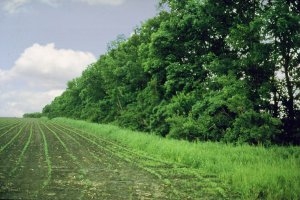 This practice is utilized as part of a crop and/or livestock operation to enhance production, protect livestock and control soil erosion. Field windbreaks protect a variety of wind-sensitive row, vegetable, orchard and vine crops; control wind erosion and increase bee pollination and pesticide effectiveness. Livestock windbreaks help reduce animal stress and mortality, reduce feed consumption and help reduce visual impacts and odors. Windbreaks also provide excellent wildlife habitat. Crops that can be produced from actively-managed windbreaks include fenceposts, firewood, Christmas trees, wreaths, nuts, berries and landscape plants. There are seven features that must be considered when establishing an effective windbreak - height, density, orientation, length, width, continuity and cross-sectional shape.
This practice is utilized as part of a crop and/or livestock operation to enhance production, protect livestock and control soil erosion. Field windbreaks protect a variety of wind-sensitive row, vegetable, orchard and vine crops; control wind erosion and increase bee pollination and pesticide effectiveness. Livestock windbreaks help reduce animal stress and mortality, reduce feed consumption and help reduce visual impacts and odors. Windbreaks also provide excellent wildlife habitat. Crops that can be produced from actively-managed windbreaks include fenceposts, firewood, Christmas trees, wreaths, nuts, berries and landscape plants. There are seven features that must be considered when establishing an effective windbreak - height, density, orientation, length, width, continuity and cross-sectional shape.
Photos - forestryimages.org, Center for Agroforestry, University of Missouri - Columbia, USDA National Agroforestry Center